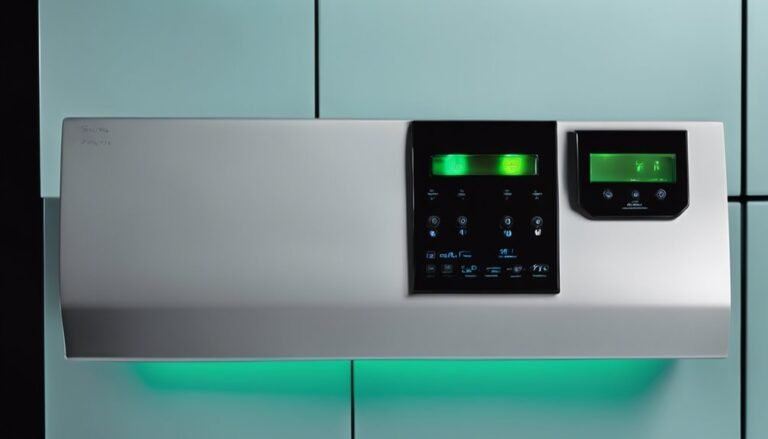Can My Water Softner Running Increase My Water Bill?
You might be surprised to learn that your water softener can indeed lead to a higher water bill. This happens primarily during the regeneration cycles, where your system uses extra water to flush out minerals. If your softener is inefficient or not the right size, it could be regenerating more often than necessary, which adds to your overall water consumption. But that's just the beginning of the story; there are several factors at play that could further impact your expenses. Curious about how to manage these costs effectively?
Key Takeaways
- Water softeners increase water consumption through regeneration cycles, potentially raising monthly water bills.
- Frequent regeneration due to inefficiency can lead to higher salt and water usage costs.
- Poorly softened water may require more water for cleaning, further increasing expenses.
- Setting regeneration to off-peak hours can help manage and reduce costs.
- Regular maintenance ensures optimal performance, preventing costly inefficiencies and unexpected bill spikes.
Understanding Water Softeners
A water softener is a device that transforms hard water into soft water, making it gentler on your plumbing and appliances. By removing minerals like calcium and magnesium, it helps prevent scale buildup, which can lead to costly repairs.
You'll appreciate the softener benefits, such as longer-lasting appliances, softer skin, and brighter laundry.
However, it's important to contemplate efficiency concerns. While softeners improve your water quality, they also require regular maintenance and salt replenishment. This means you'll need to factor in the cost of salt and potentially increased water usage during regeneration cycles.
If you're not mindful, these factors could lead to a higher water bill than you expect.
To maximize the benefits of your softener while minimizing costs, verify it's properly sized for your household. An oversized unit can result in unnecessary water and salt usage, while an undersized one may struggle to keep up with your demands.
By understanding how to optimize your water softener's performance, you can enjoy all the advantages of soft water without breaking the bank.
Take the time to evaluate your system, and you'll find a balance that works for you.
How Water Softener Works
When you use a water softener, it primarily relies on a process called ion exchange to remove hard minerals from your water.
This process not only improves the quality of your water but also influences how often the system regenerates, which can impact your water consumption.
Understanding these mechanisms helps you see how your water bill might change as you soften your water.
Ion Exchange Process
Over time, hard water can lead to scale buildup in your pipes and appliances, making it vital to understand how water softeners work. At the heart of this process is the ion exchange method. Fundamentally, your water softener swaps out hard minerals, like calcium and magnesium, for sodium ions, which are much gentler on your plumbing.
Here's a quick breakdown of the ion exchange process:
| Step | Description |
|---|---|
| 1. Hard Water In | Water enters the softener containing hard minerals. |
| 2. Ion Exchange | Hard minerals attach to resin beads, releasing sodium ions. |
| 3. Soft Water Out | The softened water flows into your home, reducing scale buildup. |
| 4. Regeneration Cycle | After a while, the resin beads get saturated and need to be regenerated. |
This ongoing water chemistry adjustment not only makes your water softer but also enhances the lifespan of your appliances. So, understanding this process can help you appreciate the benefits of a water softener and its impact on your overall water usage and costs.
Regeneration Cycle Impact
The regeneration cycle of a water softener plays an essential role in maintaining its efficiency and effectiveness. During this process, the softener flushes out accumulated minerals, like calcium and magnesium, that it's collected from your water supply.
This cycle typically occurs based on regeneration timing, which can be set according to your household's water usage patterns. By enhancing this timing, you can achieve efficiency improvement. If the cycle is too frequent, you'll waste salt and water; if it's too infrequent, your water may remain hard.
You'll want to find that sweet spot, balancing between sufficient regeneration and unnecessary waste. Most modern water softeners allow you to adjust the regeneration schedule. For instance, programming it to run during off-peak hours can help manage your water bill better.
Furthermore, some systems use demand-initiated regeneration, activating only when needed based on your actual water use. Understanding how the regeneration cycle impacts your water softener not only keeps it running smoothly but also helps you save on costs.
Water Consumption Increase
As water softeners work to remove hard minerals from your water supply, you might notice an increase in water consumption. This happens because, while your water is being softened, the system uses water for its regeneration cycle. You may find that your monthly bill reflects this increase.
To help you manage your water usage and costs, consider these water conservation tips:
- Limit water softener regeneration: Adjust the settings to regenerate less frequently.
- Use water-efficient appliances: Upgrading can notably reduce usage.
- Fix leaks promptly: Even small leaks can waste large amounts of water.
- Collect rainwater: Use it for outdoor watering needs.
- Practice mindful water usage: Turn off taps when not in use.
Performing a billing analysis can also provide insights into your water usage patterns. By understanding how your water softener impacts consumption, you can make informed decisions about your water usage and costs.
Balancing the benefits of softened water with these conservation strategies can help you manage your overall water bill while still enjoying the advantages of a water softener.
Water Usage and Softening
Many homeowners underestimate how water softening can impact their overall water usage. When you soften your water, you may notice changes in your daily habits. For instance, softer water allows soap and detergents to lather better, which can lead to using less product. This not only supports water conservation but also helps improve your cleaning efficiency.
When you adopt new usage habits, you might find yourself using less water for washing clothes or dishes.
However, it's important to be mindful of how much water your softener itself uses during regeneration cycles. These cycles can consume a significant amount of water, especially if you have an older model. By choosing a high-efficiency softener, you can minimize this impact and enhance your water conservation efforts.
To truly benefit from water softening, consider how you can adjust your daily routines. By being conscious of your usage habits, you can maximize the advantages of softened water while minimizing waste.
In the end, understanding the relationship between water softening and your overall water usage helps you make informed decisions while optimizing efficiency in your home.
Impact on Water Bills
Water softening can lead to noticeable changes in your water bills.
While you might think the cost comes solely from the water used, softener efficiency also plays a significant role. If your system isn't functioning properly, you might see some unexpected water bill adjustments.
Here are a few factors that can influence your water expenses:
- Increased Water Usage: If your softener is less efficient, it may require more water to regenerate.
- Frequency of Regeneration: More frequent regeneration cycles can lead to higher water consumption.
- Water Quality: Poorly softened water might require you to use more water for cleaning purposes.
- System Size: A softener that's too small for your household can struggle to keep up, leading to inefficiency.
- Type of Softener: Different models vary in efficiency, impacting how much water is used during regeneration.
System Maintenance Considerations
When it comes to maintaining your water softener, regular salt replacement is just the beginning.
You'll also need to clean and flush the system periodically to keep it running efficiently.
Plus, understanding the right regeneration cycle frequency can make a big difference in performance and longevity, ultimately affecting your water bill.
Regular Salt Replacement
Regular salt replacement is essential for keeping your water softener running efficiently. Neglecting this routine can lead to increased water bills, as an inefficient system uses more water than necessary.
To guarantee your water softener operates at peak performance, follow a maintenance schedule that includes regular checks on salt levels and proper salt dosage.
Here are some key points to remember about regular salt replacement:
- Check salt levels monthly: Regularly inspect the brine tank and refill as needed.
- Choose the right salt: Use high-quality salt to prevent build-up and clogs.
- Monitor your water usage: Track your water consumption to identify any increases that could indicate a problem.
- Clean the brine tank: Aim for cleaning every 6-12 months to avoid sediment accumulation.
- Follow manufacturer guidelines: Always refer to your softener's manual for specific maintenance instructions.
Cleaning and Flushing
Cleaning and flushing your water softener is vital for maintaining its efficiency and longevity. Regular maintenance helps prevent the buildup of minerals and other contaminants that can impact performance.
To guarantee your system runs smoothly, establish a cleaning frequency that suits your water usage and quality. Typically, you should clean your water softener every six months to a year, but you may need to adjust this based on local water conditions.
Flushing techniques are fundamental for effective cleaning. Start by turning off the power and water supply to your softener.
Then, remove the brine tank and clean it with a mixture of warm water and vinegar to dissolve any residue. Rinse thoroughly before reassembling.
After that, perform a full system flush by running clean water through the unit, which helps clear out any remaining debris.
Regeneration Cycle Frequency
The regeneration cycle frequency of your water softener plays an essential role in its overall performance and efficiency. If you don't optimize the regeneration timing, you might end up with an inflated water bill.
Finding the right balance is key to maintaining both your system and budget.
To help you understand the importance of cycle optimization, consider these factors:
- Water hardness: The level of minerals in your water affects how often your system needs to regenerate.
- Usage patterns: Your household's water consumption directly impacts how frequently regeneration cycles should occur.
- System capacity: A properly sized softener can manage regeneration without wasting water or salt.
- Local regulations: Some areas have guidelines on regeneration timing to conserve water.
- Maintenance routines: Regular checks and cleanings guarantee your softener operates efficiently.
Signs of Inefficiency
When your water softener isn't performing efficiently, you'll likely notice several telltale signs. One of the first things to look for is an increase in water spots on your dishes or fixtures. If your water feels slippery or leaves soap residue, it might indicate that your system isn't effectively softening the water.
You may also be dealing with inefficient settings. Check if your softener is properly calibrated; incorrect settings can lead to excessive usage of water and salt, driving up your bill.
Another sign of inefficiency is if your water softener is regenerating more frequently than usual. If it seems to be running constantly, this could point to a malfunction or a need for maintenance.
Pay attention to how often you refill the salt; if you're going through it much quicker than before, your system might be working harder than necessary.
Lastly, keep an eye on your water bill. A sudden spike can suggest that your softener is consuming more resources due to inefficiencies.
Regularly monitoring these signs can help you catch problems early and maintain your system's efficiency.
Tips to Reduce Costs
Reducing your water bill while maintaining an efficient water softener is easier than you might think.
By implementing some simple cost-cutting strategies and efficient practices, you can save money without sacrificing water quality.
Here are five practical tips to help you reduce costs:
- Use a timer: Set your water softener to regenerate during off-peak hours, which can lower energy costs.
- Check the settings: Make sure your softener is set to the correct hardness level for your water supply; over-softening can waste salt and water.
- Regular maintenance: Clean and check the system periodically to guarantee it's running efficiently and to avoid costly repairs.
- Install a demand-initiated regeneration system: This technology regenerates only when needed, saving water and salt.
- Monitor your usage: Keeping track of your water usage can help you identify trends and make adjustments as needed.
When to Seek Professional Help
Maneuvering the complexities of water softeners can sometimes feel overwhelming, and knowing when to call in a professional can save you time and money. If you're noticing a significant spike in your water bill that doesn't seem to correlate with your usage, it's wise to seek a professional assessment. An expert can help identify whether your water softener is functioning correctly or if there's a hidden issue contributing to those rising costs.
When your softener starts malfunctioning, you may find yourself faced with a variety of troubleshooting options. Rather than playing the guessing game, turning to a professional guarantees you get accurate insights and solutions tailored to your specific system. They can inspect components like valves, timers, and resin tanks, catching problems that might escape your notice.
Additionally, if you're unsure about the maintenance your system needs or if it's time for a replacement, professional guidance can clarify your options.
Frequently Asked Questions
Do Water Softeners Use Electricity During Operation?
Yes, water softeners do use electricity during operation. Their electricity consumption varies based on model and usage, but maintaining operational efficiency can help minimize energy costs, ensuring you get the most value from your system.
How Often Should I Regenerate My Water Softener?
Just as nature cycles through seasons, your water softener's regeneration frequency should align with your water usage. Typically, regenerating every 7 to 14 days keeps it efficient, ensuring peak performance and longevity in your system.
Can a Water Softener Leak and Increase My Bill?
Yes, a water softener can leak, causing water leaks that increase your bill. Even small leaks can lead to significant cost impact over time, so it's crucial to regularly check for any signs of leakage.
What Is the Average Lifespan of a Water Softener?
Coincidentally, your water softener's lifespan averages 10 to 15 years. Regular water softener maintenance can extend its life, but when it's time for a softener replacement, consider the potential costs involved.
Does My Water Hardness Level Affect Softener Efficiency?
Yes, your water hardness level greatly affects softener efficiency. Higher hardness requires more frequent regeneration, impacting overall performance. By understanding these efficiency factors, you can optimize your system for better results and potentially lower costs.
Conclusion
In the grand symphony of home management, your water softener plays an essential note. While it can raise your water bill with its regeneration cycles, you hold the conductor's baton. By optimizing settings and performing regular maintenance, you can keep the harmony intact, reducing unnecessary costs. Stay vigilant for signs of inefficiency, and remember, a well-tuned softener not only safeguards your pipes but also your wallet. With a little attention, you can enjoy soft water without breaking the bank.







